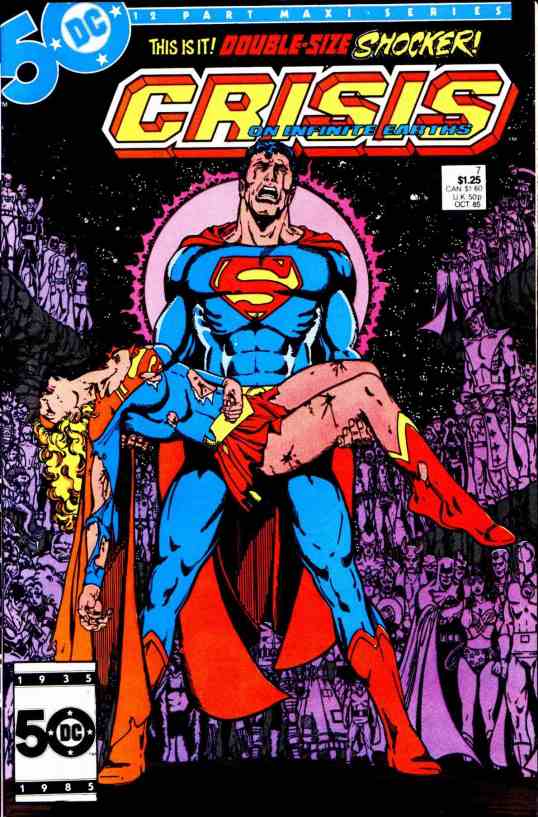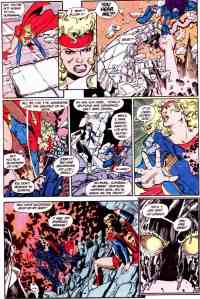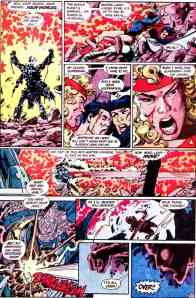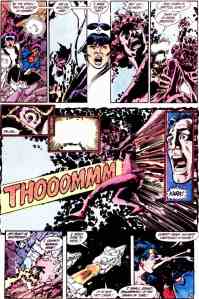POW~! Presents The 7 Greatest Moments In Comics #2: The Death of Supergirl
Crisis On Infinite Earths was NECESSARY. Do not let anyone tell you different. The reason why DC Comics was getting its ass handed to them month in and month out was because of it nigh-impenetrable continuity which could, for the most part, be attributed to the DC Multiverse. How is a 5 year old supposed to wrap his head around the idea of 2 versions of Superman teaming up in the yearly JLA/JSA crossover? Why does Wonder Woman have gray hair in an issue of Infinity Inc. yet look completely youthful in her own ongoing book? Batman and Catwoman had a daughter? See the problem? Hell I didn’t even bring up the confusion over Captain Marvel and why his giant butterfly collar was appearing in World’s Finest even though DC Editorial continued to claim the Marvel Family was regulated to Earth-S. The “S” stood for SHAZAM because DC Editorial as too clever for its own good it seems.
Do I need to bring up Captain Carrot and His Amazing Zoo Crew to confuse people further?
DC had made themselves inaccessible to new readers and it was their own damn fault. Hell, I remember trying to explain the DC Multiverse to a friend of mine that was a stalwart Marvel Comics backer and his only reply was “But why? What is the point of it?”. That question left me with no rebuttal. I mean sure it was so all the stories that came before changes that Julius Schwartz implemented in the late 50s and early 60s still “happened” but in the end it just led to more confusion for a budding market of new readers that DC desperately craved and had been losing since the advent of the Marvel Age with Amazing Fantasy #15 and The Fantastic Four #1. It wasn’t that kids didn’t want to read Batman and Superman, it’s that kids weren’t relating to Batman and Superman. They WERE relating to the everday problems of Spider-Man and the family atmosphere of The Fantastic Four. It’s not that the readership of The Justice League of America didn’t love grand scale Superheroic stories but honestly, when you’ve got a team with the Big Blue Boy Scout on it in the Silver Age of comics, no villain or team of villains stands a chance at winning. By the mid-70s DC was losing the war against Marvel and the implosion of the comics market hit them much harder than it did Smilin’ Stan Lee and his Marvel Bullpen.
By the mid-1980s DC was being crushed by the weight of its own confusing continuity. It didn’t help that since the mid-1970s only one new DC comic could be called a runaway smash hit and that was George Perez and Marv Wolfman’s New Teen Titans in 1980. Marvel was killing DC on a monthly basis, as they even took a book that had been cancelled in the early 70s due to low sales and made it into the hottest comic on the market. The mere thought of The Uncanny X-Men being flat out cancelled for low sales is unfathomable in this day and age. DC needed to get readers back and they had to do it in a major way. Enter Marv Wolfman and Len Wein, who had been asked by DC to do a companywide crossover for DC’s 50th Anniversary. Wein had been instrumental in re-launching the X-Men for Marvel and had returned to DC to write Batman and also created the original Swamp Thing. Wolfman was DC’s go to guy for good stories thanks to New Teen Titans and its magnum opus “The Judas Contract”. Together they realized this company-wide crossover was a chance to clean-up the mess of DC’s disparate continuity problems.
So was born Crisis on Infinite Earths, the 12 issue “Maxi-Series” that used pretty much EVERY character DC had its disposal. The story wasn’t simple. The long and the short if it was the Multiverse was shrinking because a being called the Anti-Monitor was destroying Parallel Earths. The Anti-Monitor traced his origin back to the creation of the current Universe, as Krona of Maltus created a machine that allowed him to look at the creation of time and space. This resulted in the Big Bang and the creation of the current Universe and an alternate Anti-Matter Universe known as Qward. The Universe gave birth to its defender in The Monitor and Qward had the Anti-Monitor. The Monitor had been introduced in New Teen Titans as what seemed to be a broker for Super-Villains and mercenaries. Even more intriguing he seemed to be able to do this across the DC Multiverse. It turns out he was doing this to find heroes capable enough to fight the Anti-Monitor who was destroying the Multiverse one Earth at a time. For seven issues the forces of the Monitor clashed with Anti-Monitor and it just seemed like the good guys couldn’t win. Even worse is that The Monitor was killed early on in the series. Even worse than that was the Anti-Monitor had created a device that would destroy the Multiverse in one fell swoop. The only solution was to take the most powerful heroes to Qward to stop him.
Crisis on Infinite Earths #7 is the issue where it all went down. A strike team featuring 2 incarnations of Superman, Supergirl, Captain Marvel, Firestorm, the Superboy of Earth-Prime (don’t ask), Lady Quark, Wildfire and countless other heavy hitters was assembled to go to Qward to stop the Anti-monitor. Seriously there were so many of DC’s “Big Guns” on the power scale involved in this I can’t begin to name them all. Of course it is a trap and when Superman of Earth-1 (i.e. The Big Blue we all know and love) comes face to face with the Anti-Monitor, Supes has finally met an adversary that even he was overmatched against. Stop and think about that for a moment. The Silver Age version of Superman was overmatched!
So when his only living relative, Kara Zor-El aka Supergirl hears him cry in agony, she does everything in her power to save him and stop the Anti-Monitor. What ensued was a brutal asskicking, as Supergirl unleashed her full might on the Anti-Monitor. Her only mistake was to turn her attention away and tell the rest of the heroes to get out of Qward and save Superman. That one moment was her undoing. That was the moment the Anti-Monitor had to save his own skin as he blasted Supergirl with a dose of pure anti-matter and then flees. Whereas he was torturing Superman moments before, with Supergirl’s beatdown he unleashed so much raw energy that it resulted in the moment that serves as the epilogue to the End of The Silver Age of Comics.
It was DC that kicked off the Silver Age in the first place. Showcase #4 in 1956 with the debut of Barry Allen as The Flash was what did it. The Flash begat the Hal Jordan version of Green Lantern, who begat the Martian Manhunter, which led to the Justice League of America. All these re-imagining of characters from the 40s led to a renewed interest in Superhero comics. It was the success the Justice League of America that led to Martin Goodman, then the owner of Marvel Comics, telling Stan Lee to come up with a team of superheroes to cash in on the JLA‘s success for Marvel. Thus Lee and cohort Jack Kirby gave us The Fantastic Four. The Silver Age lasted from 1956 until 1973 when Marvel published “The Night Gwen Stacy Died” in The Amazing Spider-Man #122. When Gerry Conway and Gil Kane killed Gwen Stacy, Peter Parker’s (aka Spider-Man’s) fiancé, the Silver Age lost its innocence. The Silver Age limped along until 1985 and had its bookend in Crisis on Infinite Earths #7 with the silhouette of Superman weeping over the corpse of his dead cousin.
One could say that the Silver Age actually ended in Crisis on Infinite Earths #8 the very next month as Barry Allen, the man who kicked off the Silver Age in the first place died next. That is not an unfair argument but Supergirl‘s death had for deeper impact for one simple reason. There was a time that Supergirl rivaled Wonder Woman in popularity for female Superheroes with comic book readers. But something happened with the advent of the Silver Age. Supergirl wasn’t a relatable character to most girls, let alone teenage girls. Supergirl’s popularity took a hit and she somehow got cast a secondary hero, a “weak sister” if you will to her cousin. Several attempts were made by DC during the Silver Age and even before Crisis on Infinite Earths to shore up her fan base but no matter what was done she couldn’t keep afloat in her own monthly comic. Marvel had really changed the game with how comics were written. It wasn’t just Action/Adventure escapism for little boys. Stan Lee, as a dialogue writer had turned Superhero comics into monthly Soap Opera installments. Monthly Soap Opera installments with lots of people in brightly colored costumes hitting each other. DC wasn’t going to change how they portrayed Supergirl anymore than Marvel would suddenly decided to portray Spider-Man as a meth-addicted pimp. Supergirl was Supergirl and nothing would change that, not even declining interest in the character.
As a comic book reader one expects the hero to overcome and be victorious time and again, especially if that character bears the bold emblem of the Kryptonian House of El. Killing Supergirl was not only shocking, it was heartbreaking. Superman crying was nothing new. We had seen him cry out of sympathy for others before, out of genuine sadness and melancholy over a situation he couldn’t help. This was the first time Superman was crying tears of rage and personal loss. We saw The Man of Steel at his most vulnerable. It remains, to my knowledge, the onetime Superman has ever said he was going to KILL someone for the sake of vengeance. The death of Supergirl ensured that Clark Kent, Kal-El of Krypton, truly was the last survivor of a doomed planet. It was the one time where not only was Superman truly grieving, but you, as a reader, were grieving for him.
The death of Supergirl made me cry. To this day, I cannot read Crisis on Infinite Earths #7 and not be moved. Supergirl‘s dying words were letting us know that she loved her cousin, not just for being her only living relative, but for the same reasons we as readers love him. His infinite compassion and love for humanity, his innate ability to always uphold the virtue of truth and justice; these are the things that Kara Zor-El loved about her cousin Kal-El. These are the things we still love about him, whether as Clark Kent or as Superman. Supergirl‘s death was tragic, but it made us remember why we love Superman and why he remains the most iconic fictional character of the 20th century.
We are almost on the 30th anniversary of Supergirl‘s death and while she has been brought back post-Crisis, it is in fact a completely different character. Ironically, the Silver Age begat scores of writers in comics that realized making the protagonist relatable actually makes for better comics. Stan Lee was really onto something there. I love the DCU version of Supergirl (I haven’t touched the DCnU version) as she is a well written teenaged character. This is a vastly different Supergirl than the one who would have goofy adventures with Streaky the Supercat or Comet the Superhorse. Arguing about who was a better Supergirl though is pointless because what is important is the core of the character. We love Supergirl for the same reasons we love Superman and watching those reasons die, watching HER die and what she represents, panel by panel in Crisis on Infinite Earths #7, is why the death of Supergirl is the second greatest moment in comics!








I’m just an anecdote, but I had no issue with the continuity of the DC Universe circa 1985. In fact, I was only 9 years old when I first bought a DC comic-CoIE #3 in fact. Yes, I had tons of questions. But those questions enticed me. I wanted to know more. Rather than turning me off, I was excited to dive in and learn more.
So for at least one young comic reader at the time, CoIE was not necessary. But then anecdotes aren’t evidence.
Pingback: I Didn’t Know I Loved Her Until They Killed Her | take another road to another time